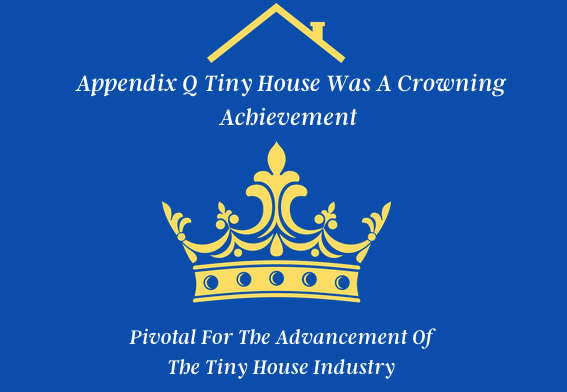Pivotal For The Advancement Of The Tiny House Industry
Washington State Tiny House Bill 5383: Effective Date Feb. 1st, 2020
Tiny House Bill 5383, which became effective on Feb. 1st, 2020 defines tiny homes and mandated that the building code council write building codes for tiny homes. Appendix Q Tiny Houses was used as a basis for the standards.
New Section: Sec. 1
Tiny houses have become a trend across the nation to address the shortage of affordable housing. As tiny houses become more acceptable, the legislature finds that it is important to create space in the code for the regulation of tiny house siting. Individual cities and counties may allow tiny houses with wheels to be collected together as tiny house villages using the binding site plan method articulated in chapter 58.17 RCW. The legislature recognizes that the International Code Council in 2018 has issued tiny house building code standards in Appendix Q of the International Residential Code, which can provide a basis for the standards requested within this act.
Washington state has amended and adopted Appendix Q Tiny House to be effective February 1st, 2021.
Tiny houses on wheels will go through the Modular inspection and approval process with L & I. This includes out of state manufacturers that sell to a consumer in Washington state.
Tiny Houses Definition: Section Five HB 5383
“Tiny house” and “tiny house with wheels” means a dwelling to be used as permanent housing with permanent provisions for living, sleeping, eating, cooking, and sanitation built in accordance with the state building code.

Michigan: Appendix Q Tiny House Is A Selected Option In ”Select IRC Options Use With The Michigan Residential Code”
The Home Builders Association of Michigan (HBAM) and the International Code Council (ICC) have joined forces to publish a targeted book of changes in the 2018 IRC to allow Home Builders Association of Michigan members and others to benefit from their new ability without having to buy the entire code. The book is titled ” 2018 Select IRC Options For Use With The Michigan Residential Code.”
Michigan Is Staying With 2015 IRC Until 2021 Is Adopted
The Flex Code Law, Public Act 504 of 2012 allows Michigan to choose to update the Michigan Residential Code every three or six years. Michigan chose not to update to the 2018 edition of the IRC published by the ICC and will be staying with the 2015 MRC until the 2021 edition of IRC is available and adopted.
HBAM and ICC Publish 2018 Select IRC Options
Appendix Q Tiny House
Appendix Q Tiny Houses was approved for inclusion in the 2018 International Residential Code ( IRC ) building code to provide regulations and standards for tiny houses on a foundation that is 400 square feet or less.
The International Residential Code is a comprehensive, stand alone residential code that creates minimum regulations for one-and two family dwellings of three stories or less.
The IRC brings together all building, plumbing, mechanical, fuel, gas, energy and electrical for provisions for one-and two-family residences. Appendix Q was adopted to the IRC building code standards through the ICC Code Developement Process.
Jurisdictions may use Appendix Q as a model code to adopt, reference or amend. Builders or even jurisdictions that have not adopted the 2018 IRC or the Appendix, can seek approval ”on a project basis through the alternative materials and designs provision” in the IRC.-David Eisenberg, co-author of The Strawbale House Book.
ASTM Global Tiny House Standards
We are at the cusp of a new pivotal moment for tiny houses, we have been in discussion with ASTM to develop new global standards for tiny houses to further progress the industry.
Learn More About The ASTM Tiny House Standards Initiative
How Can We Develop Standards To Fit The Needs Of The Different Participating Countries
Standards And Sections Of A Standard Are Like Building Blocks That Can Be Added, Subtracted, And Rearranged To Fit The Need Of Each Country.
In the United States, Appendix Q Tiny Houses was approved for inclusion in the 2018 International Residential Code ( IRC ) building code to provide regulations and standards for tiny houses on a foundation that is 400 square feet or less.
Appendix Q relaxes various requirements in the body of the code as they apply to tiny houses that are 400 square feet or less.
Attention is specifically paid to features such as compact stairs, including hand rails and headroom, ladders, reduced ceiling heights in lofts, and guard and emergency escape and rescue opening requirements of lofts.
The International Residential Code is a comprehensive, stand-alone residential code that creates minimum regulations for one-and two-family dwellings of three stories or less.
We Develop Two Standards In Tandem With Each Other
In the US, Appendix Q Tiny House has gained traction and has been adopted by over half of the country, so in order not to confuse the marketplace, this is what I am laying out as a preliminary idea.
We have proposed to develop a standard to supplement and meet the code requirements of Appendix Q Tiny House, and then we would not to be in conflict with the code. Let’s call it ASTMQ2021.
Subcommittee Name: Tiny Houses on a Foundation

Australia
Tiny Houses On A Foundation
Tiny Houses On Wheels
Australia could adopt ASTME1111, the new Tiny House Foundation Standard for foundation homes.
Reference ASTME1111 Tiny House On Foundation Standard from the floor joists up
And reference sections of the tiny house on wheels standard such
How the house adheres to the chassis, DRings, Hurricane Ties, tiny house chassis standard.
Tiny house chassis standard
Contact Janet Thome To Be Added To ASTM The Stakeholders List To Participate


